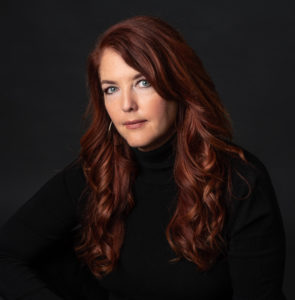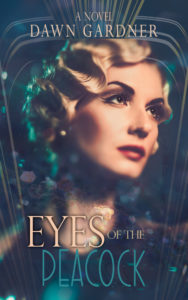By Nicholas Patterson
 A native to Virginia and lover of the Blue Ridge Mountains, Dawn Gardner embraces her creativity while outdoors. Having grown up writing songs and poems, her artistry developed into a profession of photography and writing. The Penmen Review recently had a chance to ask Gardner about her experiences with writing and self-publishing, including her fourth novel “Eyes of the Peacock.”
A native to Virginia and lover of the Blue Ridge Mountains, Dawn Gardner embraces her creativity while outdoors. Having grown up writing songs and poems, her artistry developed into a profession of photography and writing. The Penmen Review recently had a chance to ask Gardner about her experiences with writing and self-publishing, including her fourth novel “Eyes of the Peacock.”
Have you always written?
Yes. I fell in love with poetry first. When I was a young girl, I carried around Robert Louis Stevenson’s “A Child’s Garden of Verses” everywhere with me. I started writing my own poetry and song lyrics. When I was about eight, I wrote my first “large” work of fiction—a vampire love story written as a play. I’m sure that “Dark Shadows,” the soap opera, was the inspiration. I would race home after school, not wanting to miss a minute of that show. I hand-copied the play, gathered up the neighborhood kids and tried to direct them in a live production of what I had written. There was a mass rebellion, and we played kickball instead.
I have continued to write poetry throughout my life. In fact my latest novel, “Eyes of the Peacock,” originated out of a poem I wrote over 25 years ago called “Eternal.” The poem is about soulmates that meet and keep meeting through history. I am fascinated by how our lives are connected, past and present. The idea of a woman haunted by the reoccurring visions of a 1920s dancer took shape in my mind and the story evolved.
While raising my daughters, I studied and wrote screenplays. I co-wrote and published a children’s play about Shakespeare in 2001. And, unlike my vampire love story, this play was produced in an outdoor theater in Hawaii.
How do you choose the way your stories unfold in your writing?
This is an interesting question for me. I believe my stories and my main characters choose me. I love how Elizabeth Gilbert describes this phenomenon in her book “Big Magic.” Gilbert personifies ideas and how they (ideas) are searching for someone to co-create with. This theory rings true for me.
For example, years ago I was flipping through a post on social media about the mystery surrounding Jean Spangler—who was a Hollywood actress that disappeared. Years before I had heard of Jean, I had written a piece of flash fiction about Lillie Mae Parker—a woman in the 1950s who leaves secret notes for a man in a barbershop. One day out of nowhere a pivotal scene with Lillie Mae popped into my mind. I saw that her situation was similar to Jean Spangler’s, but Lillie was able to change her fate, which birthed my novel “The Cotton Blossom.” I’ve noticed a trend in my work: my main characters are strong women and overcome adversity, which is usually centered around family dynamics.
In the actual mechanics of writing, I’m not a “plotter” or a “pantser,” but something in-between. Usually, I have two or three scenes of the story that come to me completely formed. Most of the time, it’s the opening and one of the climatic scenes near the end of the second act of the novel. Then, I write and the story unfolds. As the story reveals itself, sometimes I’m surprised by new characters, plot happenings or decisions made by the cast of the novel.
What challenges do you face in your writing, and how do you overcome them?
See the above answer. When you don’t plot everything out, sometimes you might get stuck on what happens next. I reach a “sticking point” about mid-way through the second act. So far, I’ve hit this same problem in all of my novels. This phase—which I call “working the plot”—can last a few days or weeks. To resolve this, I usually do two things: Chart out my story on notebook paper or 3×5 cards and take my dogs for long walks. I find that when I release my mind from trying too hard to come up with what’s next, the subconscious mind kicks in. I’ve had full chapters and scenes come to me while walking. (The side benefit: my dogs love the extra walks.)
 What was the road to publication like for you?
What was the road to publication like for you?
Long. I finished my first novel in 2008. In the summer of 2007, a writing teacher at a workshop had me send the first thirty pages to her agent. The agent passed on the novel because she was not looking for a coming-of-age story at that time. Life happened, and for 12 years that manuscript sat on my bookshelf untouched and unpublished. During that span of time, I tinkered with a few starts of other novels and other shorter bits of fiction, but I didn’t finish anything.
In the fall of 2019, I watched my friend publish his first historical novel. It was inspiring. I told him about my finished novel and he and his wife encouraged me to publish. So in October 2019, I became an indie author. I published that novel and a novelette that had been written in 2007. Our world changed in 2020 and my photography business came to a screeching halt—so—I wrote three books in that year. I’m now writing my fifth full-length novel, and I’ve pivoted to writing instead of photography.
How do you market your work?
Self-promotion is not the easiest thing for any of us to do. But, in some ways I feel like I am marketing my strong women and not myself. That takes the pressure off. I try to be authentic in my author brand. I have passions: boots, gardening, vintage fashion and books. When I share on the social platforms, I connect with people through my novels and my passions. I’m working on finding a collection of people that enjoy my style of writing. I’m doing this slowly, keeping in mind that I’m running a marathon and not a sprint. I’m on most of the social media platforms. I do my best to post regularly, be engaging and add value. I also put out a monthly newsletter.
To me, it’s about building relationships with readers. I love hearing from people that my work has resonated with them—their correspondence sets me on fire. I actually have a notebook in Evernote called: Writing Praise. I keep screen shots of comments and reviews in there. Books are magic aren’t they? Something is extracted from the author’s mind, then is transferred it to the reader’s mind, and they absorb it, making it their own. That’s pure magic!
What do you wish you knew when you first started writing that you know now?
This list is never ending. After a while of writing (or anything for that matter), you learn and grow. This is a universal principle. Mistakes are part of the journey. I wish I hadn’t waited so long to publish.
How do you stay focused and organized while working on multiple projects?
Seasons change. So what worked last year or last week may not work today. I stay flexible. Something that has remained constant for me is a daily word count goal. This has been the best way for me to keep on track and finish projects. I write the finished daily word count on a paper calendar. Visually seeing my word count add up is motivating. I typically only write one book at a time. However, there is marketing and the business of managing your career as an author. Again, I stay flexible. At the beginning of the year, I make a list of what I want to accomplish and try my best to meet those goals.
Who are the authors that have inspired you most, and how have they inspired you?
Stephen King, Jodi Picoult, Danielle Steele, Laura Ingalls Wilder, Emily Dickinson, Walt Whitman and Ray Bradbury. King and Bradbury have inspired me through their advice for writers. “On Writing” by King is one of all-time favorite writing books. Picoult tackles controversial topics and plot lines, but she does so in a way that lets the reader decide where they stand on the subject. I admire her for that. Steele is an icon. She has been prolific and had a long career in the industry.
Dickinson was a woman trapped in a time period where women didn’t have many choices and she chose an unconventional life. Her poetry reflects that and her unorthodox usage of punctuation really resonates with me—she was a rebel. Whitman, talk about the master of self-promotion! This man could teach us all a thing or two. I love his tenacity and persistent spirit.
Laura Ingalls Wilder has my heart. I read all her books over and over again as a child. As an adult, I found out that she wrote her first book at the age of sixty-five. It’s NEVER too late to put your art into the world and she proved that to me.
If you could keep just three books in your library, which would you choose and why?
Torture. This question is pure torture. I’m assuming that I’ve been shipwrecked on a deserted island and ONLY saved three books, because this would be the only reason why I would have THREE books in my library. Once on a cross-country relocation, the moving company said I was over the weight limit. I got rid of the living room furniture and kept my books.
To answer the question, “On Writing” would be one of my choices. I’d read it for motivation and the funny stories about King’s childhood. “Walden” by Henry David Thoreau would be second. This is the kind of book you can read over and over and with each reading glean a new gem of wisdom. My collection of Shakespeare’s plays (it’s technically ONE book!) would be my final choice. His storytelling is brilliant and entertaining.
Category: